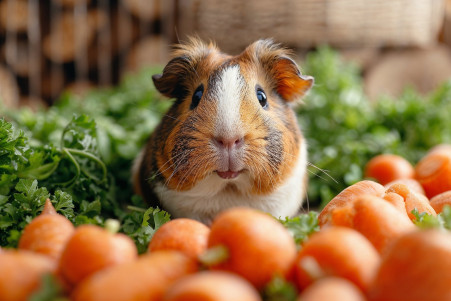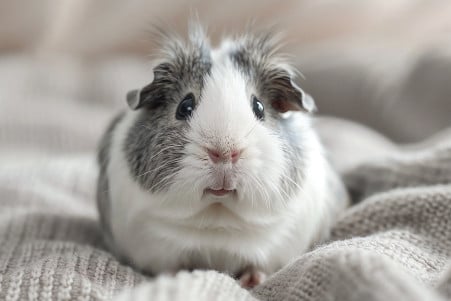Why Do Guinea Pigs Popcorn? Understanding Their Joyful Leaps
29 January 2024 • Updated 5 February 2024

If you’ve ever seen a guinea pig suddenly jump and twist in its cage, you may have wondered what exactly is going on. Known as ‘popcorning,’ guinea pigs will often jump and twist in place when they’re happy or excited.
However, it’s also been suggested that guinea pigs may popcorn in response to fear. While popcorning is most common in young guinea pigs, it’s not unheard of for adults to do it as well. Popcorning is a way for these social animals to express their feelings in a safe and healthy manner.
This article will explore the many reasons behind the fascinating behavior of popcorning in guinea pigs by looking at both animal behavior research and veterinary science. By reviewing studies in the fields of animal behavior and physiology, we can learn more about the stimuli that lead to these small pets’ big jumps and twists. This article will help you better understand the scientific reasons behind guinea pig emotions and behaviors.
Why do guinea pigs popcorn?
The Social Significance of Popcorning
In addition to being a fun and funny behavior, popcorning is also a way for guinea pigs to get exercise and, as the Omlet Blog suggests, a way to startle potential predators. This sudden, energetic leap, often accompanied by a cute little squeak, is an important part of their physical activity and helps them maintain their mobility.
While popcorning is primarily a sign of happiness, it can also be a sign of fear, so the situation in which it occurs is important.
For guinea pig owners, it’s important to know when and why a guinea pig might popcorn so they can understand what their pet is trying to communicate. As Vet Help Direct explains, while popcorning is a sign of happiness, if it’s a sign of fear, the guinea pig will look for a place to hide after they popcorn.
Paying attention to these details can make the experience of keeping guinea pigs more rewarding and help people form stronger bonds with their pets.
Popcorning also has social implications. Guinea pigs engage in a number of behaviors that help them establish their social order, and popcorning can be part of this. When people understand what popcorning means, they can learn a lot about the emotions and social dynamics of a group of guinea pigs. This knowledge can help people better appreciate the complex ways guinea pigs communicate and interact with their environment and each other.
What Guinea Pig Sounds and Behaviors Mean
Guinea pigs have a wide range of sounds and behaviors that they use to communicate with other guinea pigs and their human caretakers.
According to Petco, the sounds a guinea pig makes range from the excited wheek that they make when they want food or attention to the aggressive teeth chattering that they do when they’re mad.
These sounds, along with specific behaviors, help to give a clear picture of what’s going on with a guinea pig. For example, if a guinea pig is standing still, it could be a sign of fear, while nose touching is a sign of social interaction.
Behaviors like scent marking are used to establish territory and social hierarchy, which is another layer to their social lives. In this world of guinea pig communication, ‘popcorning’ is a sign of joy or, less commonly, a sign of being startled, which shows the complexity of their emotional lives.
Understanding and interpreting these behaviors is important for guinea pig owners who want to have a strong relationship with their pets and make sure that they feel safe and secure.
It’s also important to make sure that the environment that guinea pigs live in is conducive to their natural behaviors. And while we know that their behaviors are influenced by their environment, we also know that every leap and squeak is a sign of their happiness and well-being.
Building a Happy Home: How a Guinea Pig’s Environment Affects Popcorning
The environment a guinea pig is in has a huge impact on their overall well-being and behavior. A habitat that allows for plenty of room to move and engage in activities that stimulate the mind can lead to the happy popcorning dance, which is a sign of a happy, healthy guinea pig.
A study published in PMC found that guinea pigs that were placed in an enriched open field had more opportunities for exercise and social interactions, both of which are important for a guinea pig’s mental and physical health.
On the other hand, a habitat that is too small and doesn’t allow for natural behaviors can lead to a lack of exercise and potentially affect a guinea pig’s mental well-being. A study published in Frontiers in Zoology found that domestic guinea pigs were less likely to explore and show anxiety-like behaviors compared to wild guinea pigs, which shows just how much a guinea pig’s environment can affect their behavior.
To make sure that a guinea pig’s environment is as close to their natural habitat as possible, owners should make sure that they have hiding places, foraging opportunities, and other guinea pig companions, according to advice from FOUR PAWS International. This will help ensure that a guinea pig can popcorn and engage in other natural behaviors, which will help them live a long, happy life.
The Science of Joy: Why Guinea Pigs Popcorn
Popcorning, which is characterized by high jumps and twists, is a result of the guinea pig’s musculoskeletal and neurological systems. As explained in the Journal of Experimental Biology, the biomechanics of popcorning are similar to the bipedal hopping of other small mammals. Like hopping rodents and marsupials, who have long hindlimbs and specialized hindfeet that allow for fast, efficient movement, guinea pigs have musculoskeletal adaptations that enable them to popcorn.
Popcorning can be an important sign of a guinea pig’s well-being. Healthy, happy guinea pigs will popcorn, while those that are in pain or have limited mobility may not. A study published in PMC on the extraocular muscles of guinea pigs shows that the musculature of guinea pigs is highly complex, which is important for their agility and could also play a role in their ability to popcorn.
While the science behind popcorning is interesting, it’s also important for pet owners to know so that they can monitor their guinea pigs’ health and happiness. For example, as guinea pigs get older, they may popcorn less frequently and with less vigor, which can be a sign of their overall health and well-being.
The Science Behind Popcorning in Young Guinea Pigs
Popcorning is most common in young guinea pigs, especially during the juvenile period when their playful and active behaviors are at their peak. A paper in The Psychological Record explains that young guinea pigs show a range of social behaviors from the time they are born, with the first behaviors being focused on exploration.
The fact that popcorning is a behavior that combines physical activity with exploratory behavior suggests that the guinea pigs’ natural curiosity is a factor in the high levels of popcorning seen in young animals.
Popcorning tends to decrease as guinea pigs get older, and this decrease is often due to the natural decrease in activity that comes with age rather than a sign of poor health or well-being. The paper also explains that after weaning, guinea pigs start to show other social behaviors, including aggression and sexual behaviors, which indicates that popcorning is part of their social development.
While the age at which guinea pigs first start to popcorn can vary and the behavior may change as they get older, it remains an important sign of their emotional states and social interactions. The way that popcorning develops is closely tied to the guinea pigs’ biological and emotional development, which is a reflection of their complex social lives.
Take the Plunge: Embracing the World of Guinea Pig Popcorning
We have now explored the world of the happy leaps of guinea pigs, and learned that popcorning is a rich and varied behavior that can indicate happiness, excitement, and even fear. These joyful jumps are a form of exercise for guinea pigs that can help them stay physically and emotionally healthy.
Understanding guinea pig behaviors and emotions is important for making sure that you are taking the best care of your pet and that you have a happy, healthy relationship with them.
Environmental enrichment is a key factor in encouraging popcorning, and this shows the importance of making sure that guinea pigs have stimulating and spacious living environments.
Physiologically, a guinea pig’s ability to popcorn is dependent on their musculoskeletal health, and this is something that owners can keep an eye on to make sure that their pet is healthy. Developmentally, the frequency and intensity of a guinea pig’s popcorning is often related to their age and overall health, and younger guinea pigs are often more likely to popcorn and to do so more energetically.
In conclusion, let’s appreciate the nuance and joy that popcorning brings to guinea pig ownership. It is a behavior that captures the happy-go-lucky nature of these lovable animals. Through continued observation and study of guinea pig behaviors, enthusiasts and pet owners alike will continue to learn more about and appreciate these little friends, making sure that every popcorn is a step toward a long and loving relationship.


